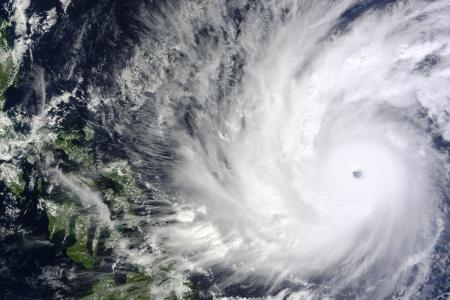Thousands evacuate as Philippines braces for typhoon Hagupit
Tens of thousands of people fled coastal villages and landslide-prone areas in the central Philippines on Friday, as typhoon Hagupit bore down on eastern coasts of the island nation where thousands were killed in a devastating storm last year.
Ports were shut across the archipelago, leaving more than 2,000 travellers stranded in the capital Manila, the central Bicol region and Mindanao island in the south, after the coastguard suspended sea travel ahead of the typhoon.

Residents with their belongings wait for a government vehicle to bring them to the evacuation centre in Tacloban city, central Philippines December 4, 2014.
Philippine Airlines and Cebu Pacific cancelled some of their flights to central and southern Philippines.
Areas yet to recover from last year’s category 5 “super typhoon” Haiyan, also known in the Philippines as Typhoon Yolanda, could be in the firing line again, the local weather bureau said.
“It’s better to evacuate early...We don’t want to experience what we went through during Yolanda,” said Gigi Calne, a housewife seeking shelter with about 3,000 others at a school in Basey, in Samar province, in central Philippines.
“It was difficult to save our family and ourselves because we moved too late.” - Gigi Calne, a housewife, talking about her experience during Typhoon Haiyan, or Yolanda, as they called it in the Philippines.

A man rests inside a church after residents evacuated their homes due to super-typhoon Hagupit in Tacloban city, central Philippines December 5, 2014.
Haiyan, one of the strongest typhoons ever to make landfall, left more than 7,000 dead or missing and more than 4 million homeless or with damaged houses when it tore through the central Philippines in November 2013.
Hagupit was churning slowly across the Pacific on Friday, with the eye of the storm around 435 km southeast of the Philippines, the weather bureau said, packing winds of up to 215 kmh near the centre with gusts of up to 250 kmh.
It was expected to slam into Eastern Samar or Northern Samar provinces in the central Philippines on Saturday afternoon, bringing torrential rain and 4- to 5-metre high storm surges, the weather bureau said.
10 million people at risk
About 10 million residents of the Bicol and Eastern Visayas regions of the central Philippines are at risk of flooding, storm surges and strong winds. AccuWeather Global Weather Center said more than 30 million people would feel the impact of the typhoon across the Philippines.
Eastern Samar and the island of Leyte were worst-hit by 250 kmh winds and storm surges brought by Haiyan. About 25,000 people still live in tents, shelters and bunkhouses more than a year later.
In Tacloban City, Leyte, which accounted for about half of the death toll from Haiyan, about 19,000 people from coastal villages thronged into 26 evacuation centres, said Ildebrando Bernadas of the city’s disaster office.
“We are expecting to double that once we implement forced evacuations,” Bernadas said, adding about 95 percent of residents from coastal areas have been evacuated.
While the local weather bureau and the Japan Meteorological Agency predicted Hagupit making a direct hit on the central Philippines, Tropical Storm Risk, which tracks cyclones, and the Joint Typhoon Warning Center of the US navy showed the storm veering north, closer to the capital Manila.
Mario Montejo, the Philippines Science and Technology Secretary, said the differences in the forecasting models were due to methodologies used, but said the actual track of the typhoon hews close to the local weather bureau’s model.
Tropical Storm Risk downgraded the typhoon to a category 4 on Friday – a level below “super typhoon” but still a very powerful storm – and forecast it would have weakened to category 3 by the time it made landfall. - Reuters
Get The New Paper on your phone with the free TNP app. Download from the Apple App Store or Google Play Store now


